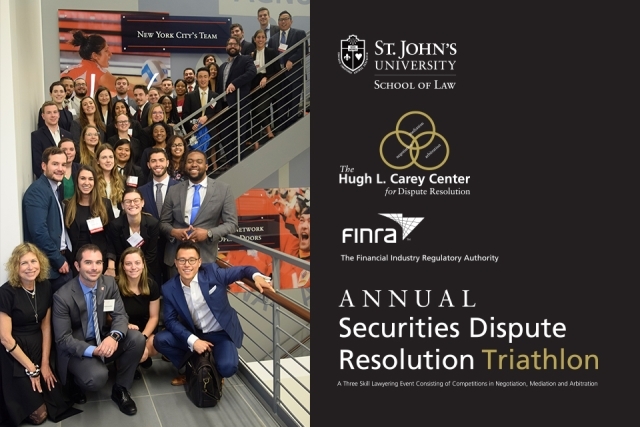
Earlier this month, St. John’s Hugh L. Carey Center for Dispute Resolution and the Financial Industry Regulatory Authority (FINRA) hosted the 11th annual Securities Dispute Resolution Triathlon.
A decade after its launch, the Triathlon remains the only competition that tests a law student’s ability in each of the three main ADR processes—negotiation, mediation, and arbitration. Students compete as advocacy lawyers, settlement counsel, and clients in a securities dispute. At the outset they try to negotiate a resolution, then they represent their clients in mediation, and finally they proceed to arbitration before a three-person panel. Professional neutrals from FINRA’s roster serve as mediators, arbitrators, and judges, giving students a realistic experience of these vital dispute resolution approaches.
An impressive 20 teams from law schools across the country participated in this year’s Triathlon, tackling a timely competition problem focused on an evolving area of law: what is a brokerage firm’s permissible scope of supervisory authority when surveilling a broker’s personal email and data that is stored on a company-issued laptop. Katherine Bayer and Stefanie Kendall from FINRA and St. John’s Law Professor Christine Lazaro collaborated with Elayne E. Greenberg, Assistant Dan for Dispute Resolution Programs, Professor of Legal Practice, Director of the Carey Center, and creator of the Triathlon, to craft a realistic problem that could be addressed from multiple perspectives.
View 2019 Triathlon Photo Gallery
An important addition to this year’s problem was the use of the gender inclusive pronouns they, them, and theirs. As explained in the problem: “Language is gender-inclusive and non-sexist when we use words that affirm and respect how people describe, express, and experience their gender. Just as sexist language excludes women’s experiences, non-gender-inclusive language excludes the experiences of individuals whose identities may not fit the gender binary, and/or who may not identify with the sex they were assigned at birth . . . .” This crucial modification was applauded by the judges, neutrals, and team participants.
Reflecting on another successful Triathlon, Professor Greenberg says: “The participants learn that, to be effective advocates, lawyers need to titrate their advocacy based on the other side’s stance, the neutral on the case, and the remedies each process offers. For many participants, the Triathlon provides a welcome opportunity to grasp advocacy nuances in these three dispute resolution processes, and to compare how the different outcomes in each process advances their client’s interests.”
Here are just some of the insights that the Triathlon participants drew from, and shared about, their competition experience:
- A multi-tier approach to conflict resolution makes sense because some ADR processes are better for some types of disputes.
- Preparation is key and part of that preparation is understanding the other side’s interests.
- My advocacy strategy has to adapt to the ADR process being used. I learned that being flexible and open-minded in the negotiation and arbitration rounds are strategies that will bring you closer to reaching a resolution. However, for arbitration, I had to be more assertive and firmer about what we wanted and why.
- Allow the clients to express their emotions so that they can have some finality.
- Reframing or rewording financial statements and figures in layman’s terms help opposing counsel, clients, and the judges relate to them with greater ease.
- I prefer the collaborative environment of negotiation and mediation.
- The further along the process you go, the harder it becomes to settle.
- Third party neutrals are so integral to ADR.
- It’s important to consider how factors outside the bare facts of the case may affect the decision of determining what is the best course of action.
The next Securities Dispute Resolution Triathlon will take place on October 17 and 18, 2020. For more information, please visit the Carey Center website.
